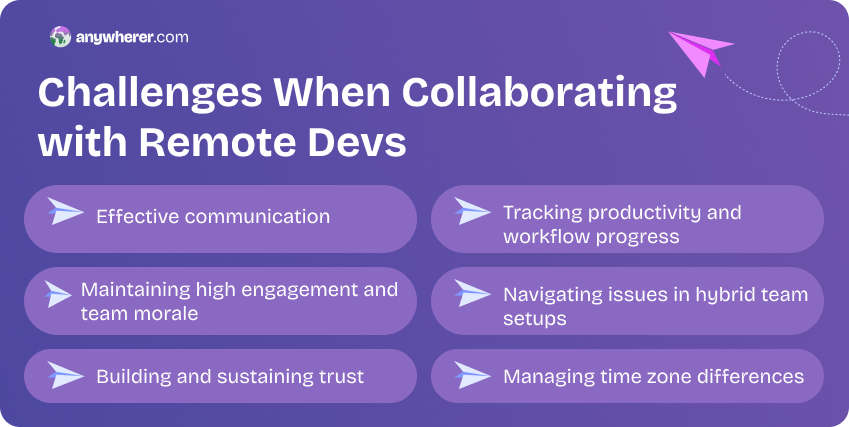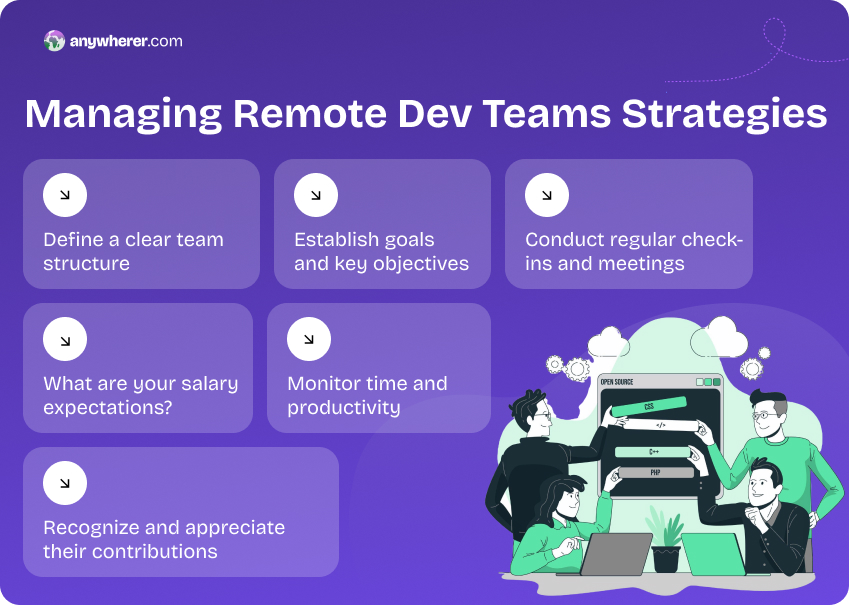Managing Remote Teams: Interesting Stats and Facts
Although many people weren’t familiar with working remotely until the pandemic, the tech industry has been using remote software development teams for years with a great deal of success. With today’s technology software, developers can work from anywhere in the world online. Managing a remote software development team is different than handling an in-house team so if you are looking to make the switch you will need to adapt your management style.
Here are a few interesting facts regarding managing remote teams:
- Small businesses are twice as likely as larger companies to hire full-time remote workers
- 18% of people work remotely full-time
- 75% of remote workers prefer a remote mode because there are fewer distractions
- 20% of workers identify communication as an obstacle to working remotely
- 74% of companies plan to shift some of their employees to remote working permanently
Common Challenges When Working with Remote Developers
When working with remote development teams globally companies may face a number of challenges. While some of them are universal for working with teams around the globe, there are also a number of local specifics and it’s important to understand cultural differences and nuances. You may actually discover the best countries to outsource software development in 2025 guide.
Using remote development teams offers a lot of advantages to companies. However, some challenges come with managing a remote team.
Here are some of the common remote team challenges you are likely to encounter:

- Communication. Communication can provide some difficulties when you hire remote development team. Different time zones and working hours can prove to be a hindrance to good communication. When you aren’t dealing with somebody face to face there is also a lack of visual cues that we often use that help us understand others.
- Low level of engagement and morale. One of the biggest problems for remote workers is loneliness and morale. They don’t feel fully engaged with the company which can lead to dissatisfaction and low morale. Leading remote teams effectively will include scheduling periodic meetings with team members to make them feel valued and provide an opportunity to give feedback on their work performance.
- Hybrid team problems. Hybrid teams, where part of the team is in the office and part is working remotely, can develop problems. The remote workers may not receive the latest updates or be included in important meeting which not only results in poorer performance but leads to the remote team feeling excluded.
- Developing trust. Trust can sometimes be an issue between remote managers and their team. Managers are concerned that team members may not be putting the work in, while members of the team will be concerned about a variety of issues ranging from getting paid for their work, to deadlines and the scope of their job. Part of how to run a successful software product team is to gain their trust by being transparent about project expectations, working hours, rates and other factors.
- Monitoring work and productivity. When you work in the same office it is relatively easy to track the productivity of team members but this is not the case with remote team management. It can be difficult to determine what the team has accomplished, which team members are producing the most and who is underperforming. You also need to avoid burnout in team members who find it difficult to disengage at the end of the work day.
Overcoming Challenges of Managing Remote Software Dev Teams: 10 Proven Strategies
Knowing how to manage an offshore development team effectively will improve productivity and efficiency while keeping your team happy and motivated. Managing a remote IT team presents some challenges but there are a variety of strategies that you can use to overcome them. Here are 10 remote teams best practices and strategies.

1. Determine a team structure
Know how to structure a startup development team to best suit your purpose. Do you want a generalist web development team structure where every team member performs multiple duties or a specialist structure where each developer focuses on only a specific part of a project? You will need to establish team size, the types of developers you need, and the role of each.
2. Set goals and objectives
When hiring dedicated development team remotely, each team member should be informed of what their role is and their place in the research and development team structure. They need to know what their specific objectives are and the indicators that goals have been met. Make sure that everything is provided in writing and that every developer clearly understands what it is you expect from them.
3. Regular meetings
Regular meetings are part of communication best practices for remote teams. It will keep you updated on progress as well as keeping team members aligned with each other. A team member will frequently need the input of another developer in order to complete their own tasks and a daily meeting is a good way for the whole team to share information and updates on related tasks. This will also enable you to identify and resolve any potential issues before they develop into a bigger problem.
4. Deal with time zones
If you manage distributed team in another time zone, interacting with them live can be done during overlapping work hours, sometimes referred to as the golden hours. For example, if you are in New York (UTC-5) and you have a dedicated development team Ukraine-based (UTC+2) there is a time difference of 7 hours. If you and your team both begin work at 9 AM and are on an 8-hour working day there is 1 hour a day – 9 AM-10 AM for you and 4 PM-5 PM for your team when you can interact live. This is the time to hold meetings and discussions. If you have a team in India (UTC+5) then there are no overlapping hours. In these cases, you will have to rely more on written reports, messaging, and other methods of communication. You will want to make sure there is a communication channel that the team can use to reach you at any time in case of an emergency.
5. Track time and productivity
There are time-tracking software tools you can use to monitor the hours your team is working but that isn’t always the best way to measure productivity. A better choice may be to establish some KPI metrics that you can use to evaluate productivity. Tracking the basic metrics of productivity allows you to see the team’s progress in numbers and understand the capabilities of each team member. It also lets each employee see for themselves any issues they may have so they can work to correct them.
6. Allow team members some flexibility
Your remote team member will appreciate it if you allow them some flexibility in their working hours. A Flexjobs survey showed that 76% of people would be more loyal to their employers if they had flexible work options. Allowing flexibility can improve morale as well as employee retention. However, don’t allow so much freedom that you find it impossible to get your team together for meetings.
7. Avoid micromanagement
Part of knowing how to manage a remote development team is being aware of when you should step back and let your developers do their job. Provide your team with the instructions they need and get regular updates to stay on top of things but be careful not to become over-controlling as it will make your team less effective.
8. Create a workplace culture
It is important while managing a remote team that you provide a vision of team culture that matches that of your company. One way how to build a strong culture with a remote team is to share your company’s mission and values as well as its vision for the future. Let your team know how the company is doing and how their contributions help. Instilling a sense of culture helps increase the commitment and productivity of team members.
9. Encourage some social interaction between team members
Your team members will interact with each other daily but generally, it will be all work-related. In-person social activities can be difficult to do when you have team members in different cities or even different countries. However, remote team bonding activities are still possible online. Some team-building ideas for remote teams might include a virtual movie night, playing online games or having a virtual lunch together. Software team building will build connections between team members as well as help boost team morale and foster a sense of team culture.
10. Show your appreciation
Make sure to let members of your team know they are appreciated. This can go a long way towards motivating remote teams. In meetings, make a point of praising those who have performed well. Conversely, avoid criticism in public. Having some kind of reward or incentive system in place is another way how to make remote teams work harder and stay motivated.
Following remote teams best practices like the above will help you meet and overcome the challenges of managing a remote team.
Collaboration Tools for Remote Development Teams
If you are building a remote engineering team you will need the right tools. Here are the collaboration tools you will need for remote development teams.
- Video conferencing tools. Your team may be remote but you can still have good face-to-face communications with the right video conferencing tool. Two of the most popular video conferencing tools are Zoom and Skype. Skype allows individual communications as well as conferences and comes pre-installed on Windows computers. Zoom has more features in its paid plans but its free version limits group meetings to 40 minutes.
- Communication management. Slack is usually the preferred communication tool to manage instant messaging between members of remote development teams. It has a fast chat room and multiple options for creating different channels for projects. You can also integrate a variety of other tools and applications with Slack including Skype and Zoom for conferencing, Google Drive and Dropbox for storage and file sharing, and Google Docs for writing and editing documents online in real-time.
- Task management tools. Another type of collaboration tool is task management software which helps you and your team by organizing and prioritizing related tasks. Jira and Trello are two of the more popular task management tools.
Working with a remote development team can be beneficial for your business. With a remote team, you will have access to a much larger talent pool. In addition, a well-managed remote software development team can reduce your expenses and increase productivity.
When building a remote software development team, also understanding the EOR definition is crucial. An Employer of Record (EOR) helps businesses legally hire and manage international developers by handling payroll, compliance, and local labor laws. Similarly, an international Professional Employer Organization (PEO) provides HR and administrative support for companies with existing entities, streamlining workforce management across multiple countries. Both solutions enable businesses to focus on productivity without administrative complexities.
FAQs on Managing Remote Software Team
How can I ensure effective communication with my remote development team?
Establish clear communication channels using tools like Slack or Microsoft Teams for instant messaging and Zoom or Google Meet for video calls. Schedule regular check-ins to discuss progress, address challenges, and ensure alignment. Encourage an open communication culture where team members feel comfortable sharing ideas and asking questions.
What are the best ways to track productivity in remote teams?
Leverage project management platforms like Jira, Trello, or Asana to assign tasks, set deadlines, and monitor progress. Incorporate time-tracking tools like Toggl or Clockify to analyze how time is spent on various projects. Regularly review team performance and provide feedback to keep productivity on track.
How can I build trust within a remote development team?
Trust is built through consistent actions and transparency. Communicate expectations, deadlines, and goals. Recognize and celebrate individual and team achievements to foster a positive work environment. Regular one-on-one meetings can help address concerns and show that you value their contributions.
How do I handle time zone differences in a remote team?
Create a shared schedule highlighting overlapping work hours and ensure that critical meetings are scheduled during these times. Use asynchronous tools like email or shared project dashboards to allow team members to contribute without requiring immediate responses. Respect personal time zones to avoid burnout and maintain work-life balance.
What’s the best way to maintain engagement in remote teams?
Offer flexibility in work schedules to accommodate individual needs. Celebrate milestones, birthdays, or team achievements through virtual gatherings or gifts. Provide opportunities for professional development, such as online courses or certifications. Encourage informal virtual hangouts or team-building activities to help the team feel more connected.
How can I ensure code quality and consistency in a remote software team?
Use version control systems like Git with clear branching strategies (for example, GitFlow), implement code reviews through platforms like GitHub or GitLab, and set up automated testing and CI/CD pipelines to maintain code standards. Encourage peer feedback and shared documentation to support alignment across the team.
Implement the best management practices and motivate your remote development team for better efficiency and productivity when working on projects!
Marharyta is a seasoned marketing expert with a rich background in supporting dedicated development teams and a keen understanding of the nuances of global remote employment solutions. With a solid track record of executing impactful campaigns, crafting strategic marketing plans, and delivering high-quality content, Marharyta plays a key role in establishing Anywherer as a reliable source in the EOR and international workforce management industry.






















